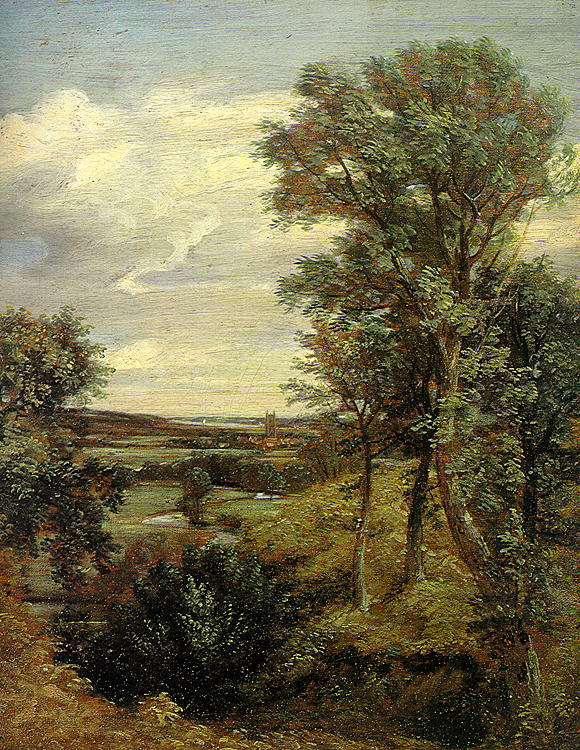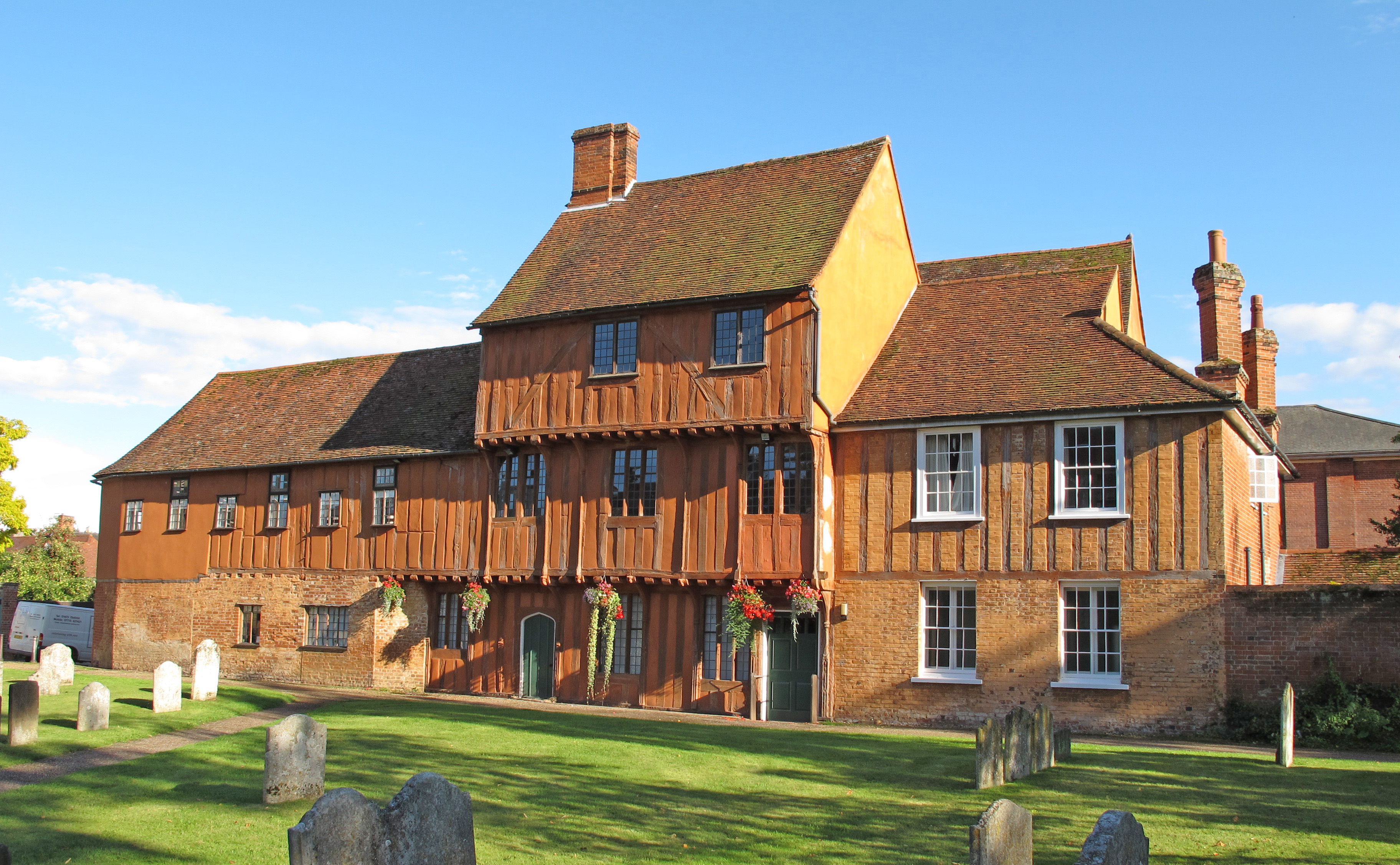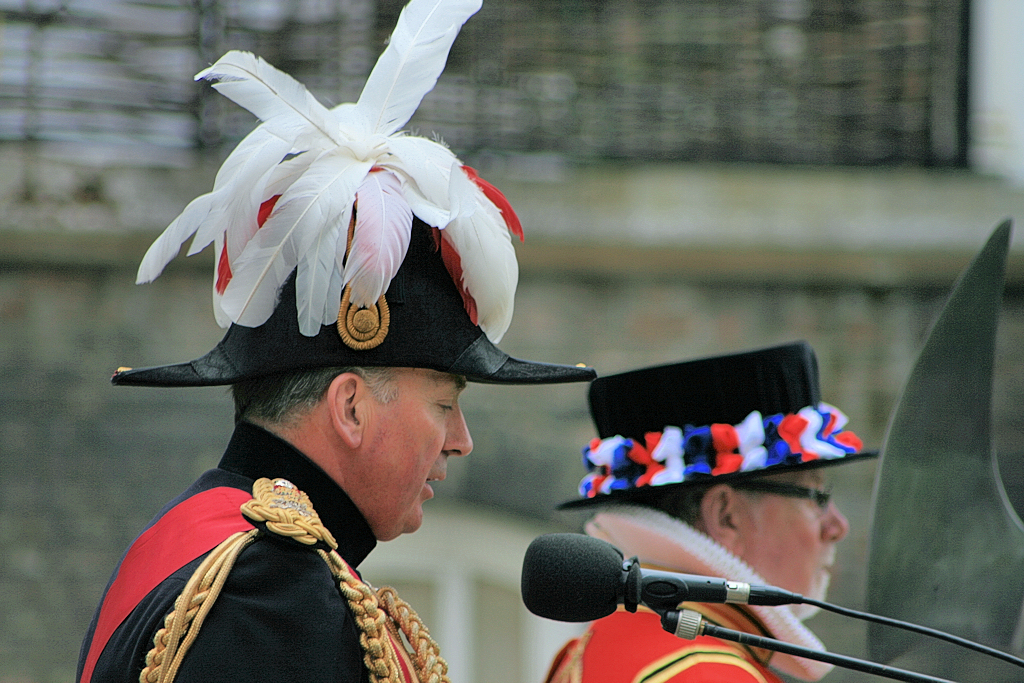|
Dedham, Essex
Dedham is a village within the borough of Colchester in northeast Essex, England, on the River Stour and the border of Essex and Suffolk. The nearest town to Dedham is the small market town of Manningtree. Governance Dedham is part of the electoral ward called Dedham and Langham. The population of this ward at the 2011 Census was 2,943. Geography Dedham is frequently rated as containing some of England's most beautiful Lowland landscape, most particularly the water meadows of the River Stour, which passes along the northern boundary of the village forming the boundary between Essex and Suffolk. Dedham has a central nuclear settlement around the Church and the junction of Mill Lane and the High Street (part of the B1029). Connected to Dedham are the hamlets of The Heath and Lamb Corner. The village forms a key part of the Dedham Vale. History Early documents record the name as Diddsham, presumably for a family known as Did or Didd. Dedham Classis In 1582–1587, a schism ... [...More Info...] [...Related Items...] OR: [Wikipedia] [Google] [Baidu] |
Colchester (borough)
The City of Colchester is a local government district with city status, in Essex, England, named after its main settlement, Colchester. The city covers an area of and stretches from Dedham Vale on the Suffolk border in the north to Mersea Island on the Colne Estuary in the south. The borough was formed on 1 April 1974 by the merger of the former borough of Colchester, covering an area of around , with the urban districts of West Mersea and Wivenhoe, along with Lexden and Winstree Rural District. Demography The ''Essex County Standard'' of September 4, 2009 said that "Government estimates" made Colchester the most populous district in the county: its officially acknowledged population is second highest among non-London boroughs, behind Northampton. According to the Office for National Statistics as of 2008, Colchester had a population of approximately 181,000. Average life expectancy was 78.7 for males. and 83.3 for females. Based on ethnic groups, predominantly of 92% of the ... [...More Info...] [...Related Items...] OR: [Wikipedia] [Google] [Baidu] |
Calvinist
Calvinism (also called the Reformed Tradition, Reformed Protestantism, Reformed Christianity, or simply Reformed) is a major branch of Protestantism that follows the theological tradition and forms of Christian practice set down by John Calvin and other Reformation-era theologians. It emphasizes the sovereignty of God and the authority of the Bible. Calvinists broke from the Roman Catholic Church in the 16th century. Calvinists differ from Lutherans (another major branch of the Reformation) on the spiritual real presence of Christ in the Lord's Supper, theories of worship, the purpose and meaning of baptism, and the use of God's law for believers, among other points. The label ''Calvinism'' can be misleading, because the religious tradition it denotes has always been diverse, with a wide range of influences rather than a single founder; however, almost all of them drew heavily from the writings of Augustine of Hippo twelve hundred years prior to the Reformation. The ... [...More Info...] [...Related Items...] OR: [Wikipedia] [Google] [Baidu] |
Royal Academy
The Royal Academy of Arts (RA) is an art institution based in Burlington House on Piccadilly in London. Founded in 1768, it has a unique position as an independent, privately funded institution led by eminent artists and architects. Its purpose is to promote the creation, enjoyment and appreciation of the visual arts through exhibitions, education and debate. History The origin of the Royal Academy of Arts lies in an attempt in 1755 by members of the Society for the Encouragement of Arts, Manufactures and Commerce, principally the sculptor Henry Cheere, to found an autonomous academy of arts. Prior to this a number of artists were members of the Society for the Encouragement of Arts, Manufactures and Commerce, including Cheere and William Hogarth, or were involved in small-scale private art academies, such as the St Martin's Lane Academy. Although Cheere's attempt failed, the eventual charter, called an 'Instrument', used to establish the Royal Academy of Arts over a decad ... [...More Info...] [...Related Items...] OR: [Wikipedia] [Google] [Baidu] |
Sir Alfred Munnings
Sir Alfred James Munnings, (8 October 1878 – 17 July 1959) was known as one of England's finest painters of horses, and as an outspoken critic of Modernism. Engaged by Lord Beaverbrook's Canadian War Memorials Fund, he earned several prestigious commissions after the Great War that made him wealthy. Between 1912 and 1914 he was a member of the Newlyn School of artists. His work was part of the art competitions at the 1928 Summer Olympics, the 1932 Summer Olympics, and the 1948 Summer Olympics. Munnings was president of the Royal Academy of Arts from 1944 until his death. Biography Alfred Munnings was born on 8 October 1878 at Mendham Mill, Mendham, Suffolk, across the River Waveney from Harleston in Norfolk to Christian parents. His father was the miller and Alfred grew up surrounded by the activity of a busy working mill with horses and horse-drawn carts arriving daily. After leaving Framlingham College at the age of fourteen he was apprenticed to a Norwich printer, des ... [...More Info...] [...Related Items...] OR: [Wikipedia] [Google] [Baidu] |
Hadleigh, Suffolk
Hadleigh () is an ancient market town and civil parish in South Suffolk, East Anglia, situated, next to the River Brett, between the larger towns of Sudbury and Ipswich. It had a population of 8,253 at the 2011 census. The headquarters of Babergh District Council were located in the town until 2017. Origin of the name Skeat, in his 1913 ''The Place-Names of Suffolk'', says this: Spelt ''Hadlega'', R.B.; ''Hadleigh'', Ipm.; ''Hædleage'', in a late chapter, Thorpe, Diplomat, 527; ''Headlega'', Annals of St Neot, quoted in Plummer's ed. of the A.S.Chronicle, ii. 102; ''Hetlega'', D.B., p.184. In D.B. the ''t'' stands for ''th''; and the true A.S. form appears in a Worcs. charter, dated 849, as ''hæðleage''(gen.) with reference to Headley Heath (a tautological name) in Birch, C.S. ii. 40; see Duignan, Placenames of Worcs. The sense is 'heath-lea.' In a similar way the A.S. ð has become t in Hatfield (Herts.) which means 'heath-field'. History Guthrum, King of the Dan ... [...More Info...] [...Related Items...] OR: [Wikipedia] [Google] [Baidu] |
East Anglian School Of Painting And Drawing
The East Anglian School of Painting and Drawing was an art learning environment established by Cedric Morris and Arthur Lett-Haines in East Anglia in 1937. It was run on very idiosyncratic lines based upon the ''"free rein"'' approach that was then current in French academies. It had a great influence on many Suffolk artists and made an important contribution to art teaching in the east of England for forty years. Foundation The school was founded by Morris and Lett-Haines on 12 April 1937 in an old house in the centre of Dedham, Essex. In addition to the proprietors, there was a third teacher Ian Brinkworth a secretary, model and one student when it opened. By December 1937 there were 60 students and the school held its first exhibition. The school was described in a prospectus as ''"an oasis of decency for artists outside the system"''. Lett-Haines taught theory, whereas Morris taught by encouragement and example. Lucian Freud was among the earliest students joining at the age o ... [...More Info...] [...Related Items...] OR: [Wikipedia] [Google] [Baidu] |
Arthur Lett-Haines
Arthur Lett-Haines (1894 – 25 February 1978Deaths, ''The Times'', 2 March 1978), known as Lett Haines, was a British painter and sculptor who experimented in many different media, though he generally characterised himself as "an English surrealist". He was part of a London artistic circle, which included D. H. Lawrence, the Sitwells and Wyndham Lewis, but for most of his life lived with the painter and gardener Cedric Morris in Cornwall, Paris and finally Suffolk. Biography Arthur Lett was born 2 November 1894, at 9 Walterton Road, Paddington, London, the son of Charles Lett and Frances Laura Esme Lett (who afterwards married S. Sidney Haines). He was educated at St Paul's School, London. In 1911, initially intending to enter farming, he was a 16-year-old pupil on the farm of Henry Charles Frank at Poslingford Hall, Clare, Suffolk. In the First World War he served in the British Army. In 1916 Lett-Haines married (as his second wife; he had been left a widower whilst still ... [...More Info...] [...Related Items...] OR: [Wikipedia] [Google] [Baidu] |
Cedric Morris
Sir Cedric Lockwood Morris, 9th Baronet (11 December 1889 – 8 February 1982) was a British artist, art teacher and plantsman. He was born in Swansea in South Wales, but worked mainly in East Anglia. As an artist he is best known for his portraits, flower paintings and landscapes. Early life Cedric Lockwood Morris was born on 11 December 1889 in Sketty, Swansea, the son of George Lockwood Morris, industrialist and iron founder, and Wales rugby international, and his wife Wilhelmina (née Cory, see Cory baronets). He had two sisters – Muriel, who died in her teens, and Nancy (born in 1893). His mother had studied painting and was an accomplished needlewoman; on his father's side he was descended from Sir John Morris, 1st Baronet, whose sister Margaret married Noel Desenfans and helped him and his friend, Francis Bourgeois, to build up the collection now housed in the Dulwich Picture Gallery. Cedric was sent away to be educated, at St Cyprian's School, Eastbourne, and Chart ... [...More Info...] [...Related Items...] OR: [Wikipedia] [Google] [Baidu] |
East Bergholt
East Bergholt is a village in the Babergh District of Suffolk, England, just north of the Essex border. The nearest town and railway station is Manningtree, Essex. East Bergholt is north of Colchester and south of Ipswich. Schools include East Bergholt High School, a comprehensive for children aged 11–16, and a primary school. During the 16th century, its inhabitants became well known for Protestant radicalism A few of its citizens were martyred during the reign of Queen Mary I, and the Protestant martyrologist John Foxe recorded their stories in his famous work ''Acts and Monuments'' (also known as ''Foxe's Book of Martyrs''). East Bergholt is the birthplace of painter John Constable whose father owned Flatford Mill. Flatford and Dedham, Essex, both made famous by John Constable, are within walking distance of East Bergholt. St Mary's Church and bell cage ThChurch of St Mary the Virginwas built in the 15th and 16th centuries, but is well known for the absence of a towe ... [...More Info...] [...Related Items...] OR: [Wikipedia] [Google] [Baidu] |
John Constable
John Constable (; 11 June 1776 – 31 March 1837) was an English landscape painter in the Romanticism, Romantic tradition. Born in Suffolk, he is known principally for revolutionising the genre of landscape painting with his pictures of Dedham Vale, the area surrounding his home – now known as "Constable Country" – which he invested with an intensity of affection. "I should paint my own places best", he wrote to his friend John Fisher in 1821, "painting is but another word for feeling". Constable's most famous paintings include ''Wivenhoe Park (painting), Wivenhoe Park'' (1816), ''The Vale of Dedham (painting), Dedham Vale'' (1821) and ''The Hay Wain'' (1821). Although his paintings are now among the most popular and valuable in Art of the United Kingdom, British art, he was never financially successful. He became a member of the establishment after he was elected to the Royal Academy of Arts at the age of 52. His work was embraced in France, where he sold more than in his ... [...More Info...] [...Related Items...] OR: [Wikipedia] [Google] [Baidu] |
Constable DeadhamVale
A constable is a person holding a particular office, most commonly in criminal law enforcement. The office of constable can vary significantly in different jurisdictions. A constable is commonly the rank of an officer within the police. Other people may be granted powers of a constable without holding this title. Etymology Historically, the title comes from the Latin ''comes stabuli'' (attendant to the stables, literally ''count of the stable'') and originated from the Roman Empire; originally, the constable was the officer responsible for keeping the horses of a lord or monarch.p103, Bruce, Alistair, ''Keepers of the Kingdom'' (Cassell, 2002), Constable Encyclopædia Britannica online The title was imported to the |
William Tecumseh Sherman
William Tecumseh Sherman ( ; February 8, 1820February 14, 1891) was an American soldier, businessman, educator, and author. He served as a general in the Union Army during the American Civil War (1861–1865), achieving recognition for his command of military strategy as well as criticism for the harshness of the scorched-earth policies that he implemented against the Confederate States. British military theorist and historian B. H. Liddell Hart declared that Sherman was "the first modern general". Born in Ohio into a politically prominent family, Sherman graduated in 1840 from the United States Military Academy at West Point. He interrupted his military career in 1853 to pursue private business ventures, without much success. In 1859, he became superintendent of the Louisiana State Seminary of Learning & Military Academy (now Louisiana State University), a position from which he resigned when Louisiana seceded from the Union. Sherman commanded a brigade of volunteers at ... [...More Info...] [...Related Items...] OR: [Wikipedia] [Google] [Baidu] |









